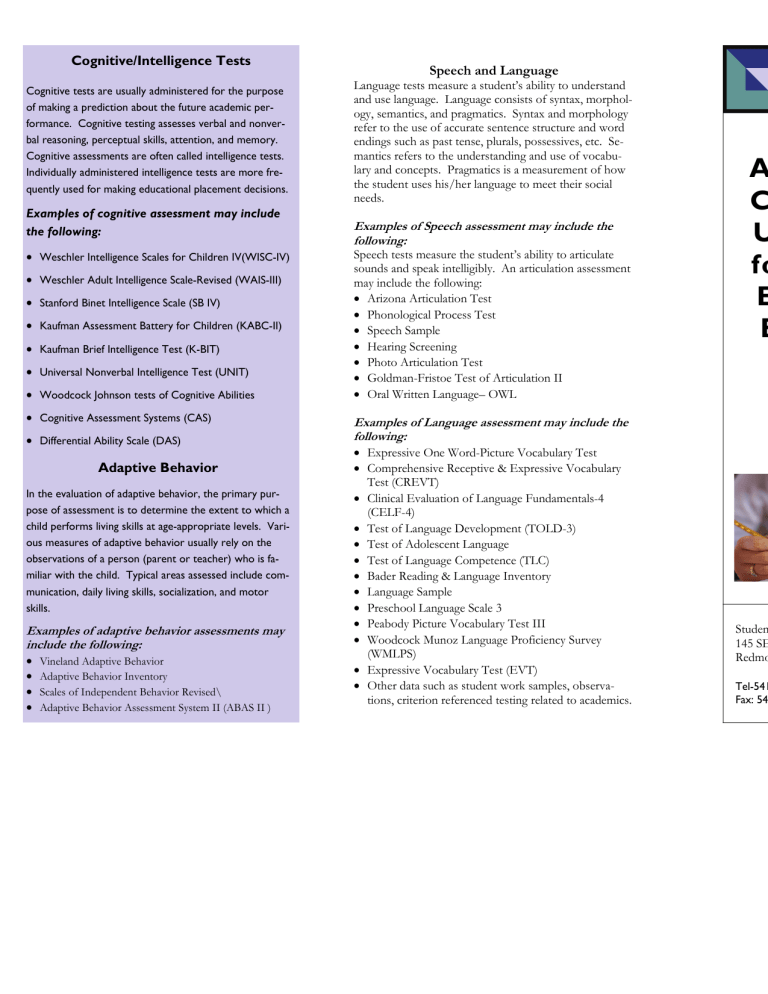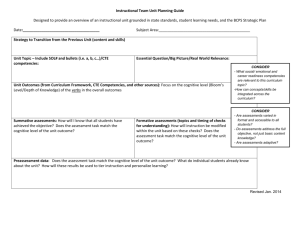ACU fo EE - Redmond School District

Cognitive/Intelligence Tests
Cognitive tests are usually administered for the purpose of making a prediction about the future academic performance. Cognitive testing assesses verbal and nonverbal reasoning, perceptual skills, attention, and memory.
Cognitive assessments are often called intelligence tests.
Individually administered intelligence tests are more frequently used for making educational placement decisions.
Examples of cognitive assessment may include the following:
Weschler Intelligence Scales for Children IV(WISC-IV)
Weschler Adult Intelligence Scale-Revised (WAIS-III)
Stanford Binet Intelligence Scale (SB IV)
Kaufman Assessment Battery for Children (KABC-II)
Kaufman Brief Intelligence Test (K-BIT)
Universal Nonverbal Intelligence Test (UNIT)
Woodcock Johnson tests of Cognitive Abilities
Cognitive Assessment Systems (CAS)
Differential Ability Scale (DAS)
Adaptive Behavior
In the evaluation of adaptive behavior, the primary purpose of assessment is to determine the extent to which a child performs living skills at age-appropriate levels. Various measures of adaptive behavior usually rely on the observations of a person (parent or teacher) who is familiar with the child. Typical areas assessed include communication, daily living skills, socialization, and motor skills.
Examples of adaptive behavior assessments may include the following:
Vineland Adaptive Behavior
Adaptive Behavior Inventory
Scales of Independent Behavior Revised\
Adaptive Behavior Assessment System II (ABAS II )
Speech and Language
Language tests measure a student’s ability to understand and use language. Language consists of syntax, morphology, semantics, and pragmatics. Syntax and morphology refer to the use of accurate sentence structure and word endings such as past tense, plurals, possessives, etc. Semantics refers to the understanding and use of vocabulary and concepts. Pragmatics is a measurement of how the student uses his/her language to meet their social needs.
Examples of Speech assessment may include the following:
Speech tests measure the student’s ability to articulate sounds and speak intelligibly. An articulation assessment may include the following:
Arizona Articulation Test
Phonological Process Test
Speech Sample
Hearing Screening
Photo Articulation Test
Goldman-Fristoe Test of Articulation II
Oral Written Language– OWL
Examples of Language assessment may include the following:
Expressive One Word-Picture Vocabulary Test
Comprehensive Receptive & Expressive Vocabulary
Test (CREVT)
Clinical Evaluation of Language Fundamentals-4
(CELF-4)
Test of Language Development (TOLD-3)
Test of Adolescent Language
Test of Language Competence (TLC)
Bader Reading & Language Inventory
Language Sample
Preschool Language Scale 3
Peabody Picture Vocabulary Test III
Woodcock Munoz Language Proficiency Survey
(WMLPS)
Expressive Vocabulary Test (EVT)
Other data such as student work samples, observations, criterion referenced testing related to academics.
Studen
145 SE
Redmo
Tel-541
Fax: 54
A
C
U fo
E
E
OVERVIEW
The purpose of evaluation is to provide student, parents, teachers, school psychologists, and other professionals with information to assist them in making decisions regarding the identification, program, and placement of children eligible for special education.
It is important to remember that a referral for an evaluation means that you or your child’s teacher need more information in order to better understand how to help her or him achieve success at school.
If your child is referred for evaluation you must give permission before our testing can begin. It is important for parents to understand why testing is requested, what areas of learning and development will be assessed by the testing, what types of tests will be given, and how the test results will be used to help your child.
The results of the tests will be shared with you once the evaluation is completed.
Commonly Used Tests for Special
Education Eligibility and Program
Planning
Achievement
Achievement test that directly assess student’s skill development in academic areas such as reading, math, and written language. They measure the extent to which a student has profited from schooling and/or life experiences compared to others of the same age or grade.
Achievement test provide a global index of academic skill development and may be used to identify individual students for whom educational intervention is necessary.
Achievement tests are used most often to assess students in an effort to identify those who demonstrate relatively low-level, average or high-level skills in comparison to their peers.
Examples of achievement tests for screening students may include the following:
Kaufman Tests of Educational Achievement II
Weschler Individual Achievement Test (WIAT-II)
Woodcock Johnson Tests of Achievement III (WJ III)
Curriculum Based Assessments (CBM)
Achievement test for diagnosing specific skill development may include the following:
Reading Inventories-Oral Reading Fluency
Brigance Basic Skills Inventory
Woodcock Reading Mastery Test
Key Math Diagnostic Test
Test of Written Expression and Spelling
DIBELS-Dynamic Indicators of Basic Early Literacy
Skills
CWS– Correct Writing Sequences
Other data such as student work samples, observations and curriculum based measurements.
Behavior
Tests of person evaluate a child’ expectations. T emotional, and b lish instructiona as delayed. Met scales, self-repo observational pr istics.
Assessments in lowing:
Attention De
Conners Pare
Behavioral Ev
Behavior Rat
Achenbach C
Children’s D
Devereaux C
Behavior Ass
Other data s and Function
Assessments of following:
Draw-a-perso
Roberts App
Reynolds Ad

